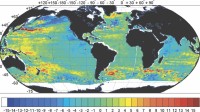By Carl Wunsch, MIT et al. in Journal of Climate
Abstract:
Estimates of regional patterns of global sea level change are obtained from a 1 degree horizontal resolution general circulation model constrained by least squares to about 100 million ocean observations and many more meteorological estimates during the period 1993-2004. The data include not only altimetric variability, but most of the modern hydrography, Argo float profiles, sea surface temperature, and other observations. Spatial-mean trends in altimetric data are explicitly suppressed to isolate global average long-term changes required by the in situ data alone.
On large scales, some regions display strong signals although few individual points have statistically significant trends. In the regional patterns, thermal, salinity, and mass redistribution contributions are all important, showing that regional sea level change is tied directly to the general circulation. Contributions below about 900 m are significant, but not dominant, and are expected to grow with time as the abyssal ocean shifts. Estimates made here produce a global mean of about 1.6 mm/yr, or about 60% of the pure altimetric estimate, of which about 70% is from the addition of freshwater.
Interannual global variations may be dominated by the freshwater changes rather than by heating changes. The widely quoted altimetric global average values may well be correct, but the accuracies being inferred in the literature are not testable by existing in situ observations. Useful estimation of the global averages is extremely difficult given the realities of space-time sampling and model approximations. Systematic errors are likely to dominate most estimates of global average change: published values and error bars should be used very cautiously.

Twelve-year (1993-2004) trend in sea level (mm yr/1; updated from CN2004) as determined directly from the TOPEX/Poseidon altimetric data. See larger image here.
From Conclusion:
At best, the determination and attribution of global mean sea level change lies at the very edge of knowledge and technology. The most urgent job would appear to be the accurate determination of the smallest temperature and salinity changes that can be determined with statistical significance, given the realities of both the observation base and modeling approximations. Both systematic and random errors are of concern, the former particularly, because of the changes in technology and sampling methods over the many decades, the latter from the very great spatial and temporal variability. It remains possible that the database is insufficient to compute mean sea level trends with the accuracy necessary to discuss the impact of global warming - as disappointing as this conclusion may be. The priority has to be to make such calculations possible in the future. See pdf from MIT here.




